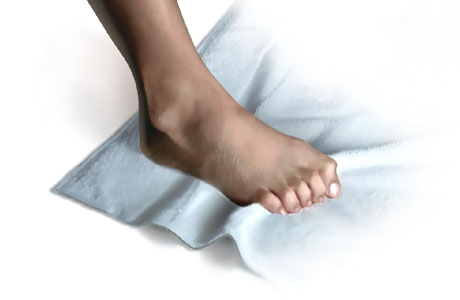Arch Pain Causes
Overview
Arch pain (usually Plantar Fasciitis) is pain that is usually felt first thing in the morning or after rising up from a prolonged resting position and pain increases after more use of feet. The causes of arch pain include: weight, a foot injury, overuse, abnormal biomechanics of the foot (e.g. flat feet or abnormal pronation), footwear, certain activities, inappropriate training, and medical conditions (eg. rheumatoid arthritis). Treatment of arch pain include weight reduction, rest, ice, activity modification, anti-inflammatory products, sports massage, stretching, strengthening, acupuncture, strapping, steroid injection, ultrasound and orthotics. 
Causes
The most common cause of arch pain is plantar fasciitis. Plantar fasciitis is the name that describes inflammation of the fibrous band of tissue that connects the heel to the toes. Symptoms of plantar fasciitis include pain early in the morning and pain with long walks or prolonged standing. Arch pain early in the morning is due to the plantar fascia becoming contracted and tight as you sleep through the night. When awakening and walking in the morning, the fascia is still tight and prone to irritation when stretched. When walking or standing for long periods, the plantar fascia becomes inflamed and painful. Treatment of plantar fasciitis is best accomplished with some simple stretching exercises, anti-inflammatory medications, and inserts for your shoes.
Symptoms
Bones and ligaments work together to form joints, and bones are joined together by ligaments. Strains occur in ligaments. In the arch, there are ligaments that are located at the ends of each bone. These ligaments connect the bones to other bones on both ends and on the sides. Point tenderness and looseness of a joint are indicators of a sprain. Fractures are indicated by point tenderness that may be severe over the area of bone that is affected. There may be a distinguishable lump or gap at the site of the fracture. A rotated toe or forefoot may also be a sign of a fracture.
Diagnosis
The doctor will examine your feet for foot flexibility and range of motion and feel for any tenderness or bony abnormalities. Depending on the results of this physical examination, foot X-rays may be recommended. X-rays are always performed in a young child with rigid flatfeet and in an adult with acquired flatfeet due to trauma.
Non Surgical Treatment
If the strain is severe enough, it can not only stretch but tear the plantar fascia. No matter what the cause of your problem, however, the end result is the same, foot pronation, a temporary case of "flat feet" and pain. The best treatment? Apply ice packs, followed by heat (to reduce inflammation), to the area for 20 minutes once a day. Rest is also essential. You will have to avoid any activity, in some cases, even standing or walking, that would increase the tear, until the tissue heals on its own (this can sometimes take up to six weeks). With strains and less severe tears, you may be able to walk on the foot with arch-support shoe inserts. You'll need to see your doctor for more permanent arch support. A doctor can also provide immediate relief from the pain of plantar fasciitis by giving you a local cortisone injection or prescribing anti-inflammatory medication. 
Surgical Treatment
Although most patients with plantar fasciitis respond to non- surgical treatment, a small percentage of patients may require surgery. If, after several months of non-surgical treatment, you continue to have heel pain, surgery will be considered. Your foot and ankle surgeon will discuss the surgical options with you and determine which approach would be most beneficial. No matter what kind of treatment you undergo for plantar fasciitis, the underlying causes that led to this condition may remain. Therefore, you will need to continue with preventive measures. Wearing supportive shoes, stretching, and using custom orthotic devices are the mainstays of long-term treatment for plantar fasciitis.
Prevention
Stretch and strengthen important muscles in your feet, ankles and legs in order to guard against future strain. Make sure to acquire suitable arch supports and inserts if necessary, and that your shoes are shock absorbent and in good condition. Wearing tattered shoes provides no protection, and runners should replace their footwear before exceeding 500 miles of usage. Athletes new to arch supports should gradually build their training routine, allowing their feet to become accustomed to a new stance.